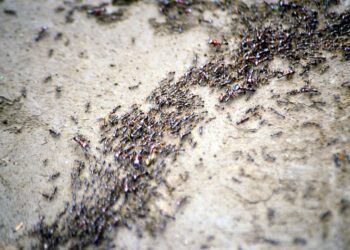
(Photo T.R.S.). b SEM image of ant cuticle with crystalline coating. Credit: Nature Communications.
Calcareous biominerals have been incorporated by many animals across evolutionary history, particularly by crustaceans with their signature shells. Somewhat surprisingly, this kind of protection has never been seen before in insects, which belong to the same group as crustaceans — both are arthropod classes. But scientists have now found the first evidence of high-magnesium calcite in the armor overlaying the exoskeletons of leaf-cutter ants (Acromyrmex echinatior).
Armored bacteria farmer
For a number of years, Cameron Currie, a University of Wisconsin–Madison professor of bacteriology, has been studying Streptomyces bacteria. Currie and colleagues showed that these microbes provide leaf-cutter ants with protection against infections, which suggests that both the ants and their microbiome could become a new source of antibiotics. Bearing in mind the frightening rise of antibiotic-resistant bacteria, this research is extremely important, perhaps even crucial.
While they were studying leaf-cutter ants in an effort to identify what the insects might give in return for the protection they receive, Hongjie Li, a postdoctoral scientist at Currie’s lab, discovered crystals on the surface of the exoskeletons. On closer inspection, it turned out that the crystals were biominerals — the very first to be encountered in the insect world.
On the morning that Li performed the X-ray scans of the ants, he couldn’t believe his eyes.
“I texted Cameron right away by saying ‘I found a rock ant’. I still can feel the joyful moment right now,” Li, who is the first author of the new study published in Nature Communications, told ZME Science.
Subsequent live-rearing and in vitro synthesis experiments showed that the magnesium-rich calcite armor develops as the ants mature, thereby increasing the hardness of their exoskeletons.
The high magnesium content of the armor is particularly exciting, Currie told me, because it is very rare in the biosphere. “So, our ants have really unique and strong armour,” the researcher added.

Worker ants with biomineralized exoskeletons were more likely to survive encounters with Atta cephalotes soldier ants, according to observations performed by the researchers. What’s more, the armor also offered protection against infection from the disease-causing fungus Metarhizium anisopliae.
Apparently, there are quite a few reasons why such an armor must have been favored by natural selection. But intriguingly, the researchers liken the ants’ bacterial farming to human agriculture.
“Leaf-cutter ants evolved around 20 million years ago and are ecologically dominant in the new world tropics. Their success parallels the important role agriculture plays in the rise of human dominance over the planet over the last 10,000 years. There are other parallels between these ant and human agriculturalists. Like crop pathogens causing pestilence over human agricultural history, the ant crops are highly susceptible to specialized pathogens that have evolved to exploit them. Just as humans rely on chemicals to defend our crops, the ants have evolved the use of bacteria to derive antibiotics to control crop infection,” Currie told ZME Science.
“Our finding of biomineral armor in a leaf-cutting ant provides another exciting new parallel to humans: the evolution of protective armor for engaging in wars with other agriculturalists,” he added.
There may be more insects with biomineral armor. One of the reasons why they’re not common is because most insects already have a hard, sturdy exoskeleton, which generally offers sufficient protection. In the future, Currie and colleagues would like to study in more detail how the biomineral forms, as well as the evolutionary origins of the armor across the ants that grow fungus gardens.






